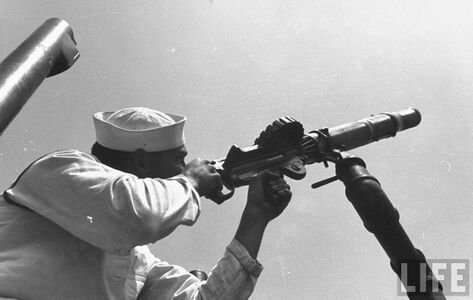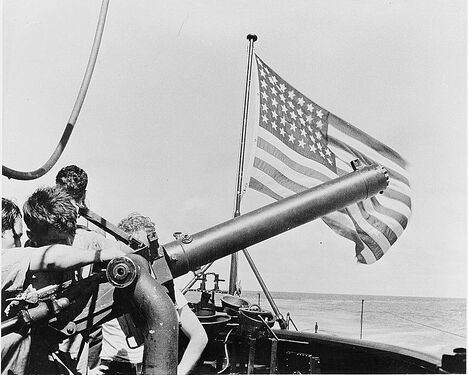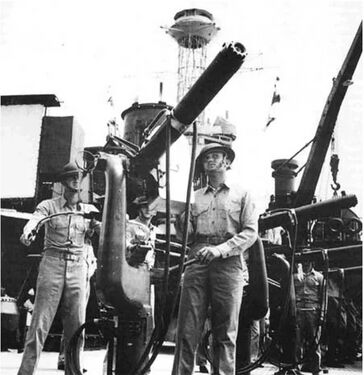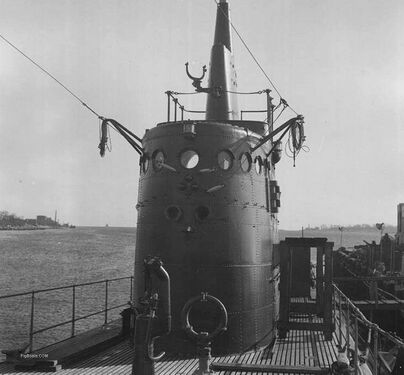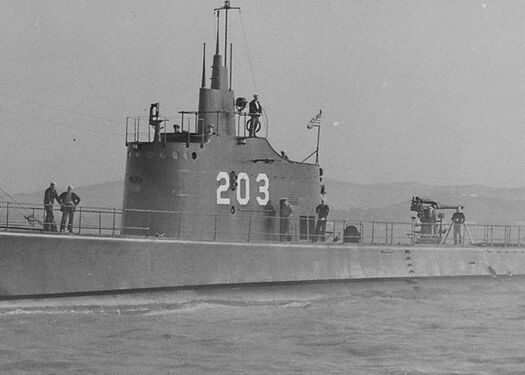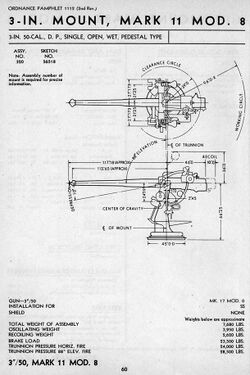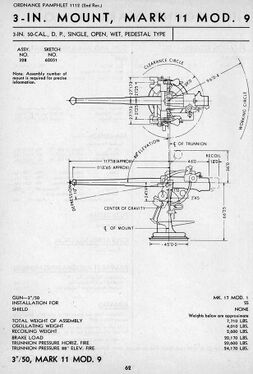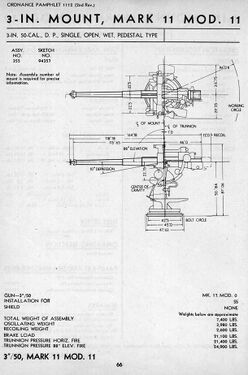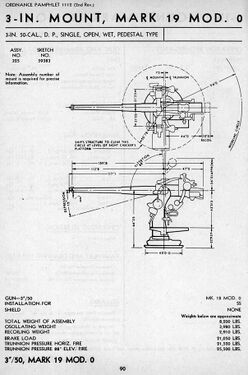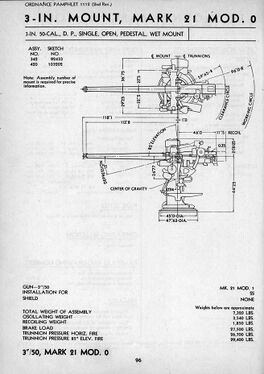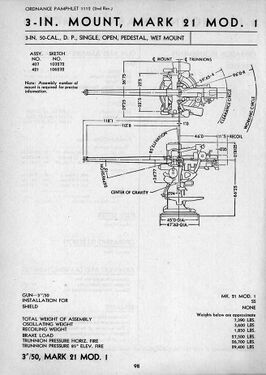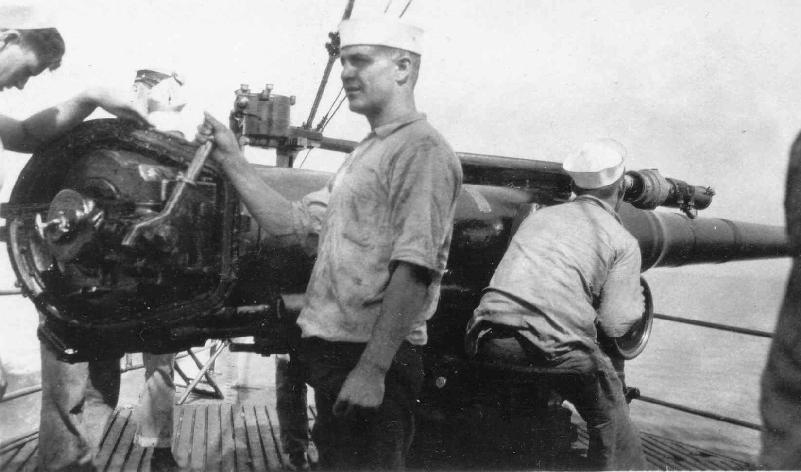Gun photos & information: Difference between revisions
Pbcjohnston (talk | contribs) |
Pbcjohnston (talk | contribs) |
||
| (45 intermediate revisions by the same user not shown) | |||
| Line 13: | Line 13: | ||
</gallery> | </gallery> | ||
</center> | </center> | ||
The M1917 Lewis light machine gun rose to prominence during WWI. It was a popular infantry weapon on the front in Europe and it also saw extensive use on aircraft. Despite being only .30-06 caliber, it had an imposing look due to the large heat-sink cooling tube that surround the main barrel. This tube had fins on the inside that helped to disperse heat while firing. The 47 round pan magazine sat atop the weapon and could be quickly changed. The Navy adopted the weapon during the war and it became the first machine gun to equip U.S. submarines. It was used as a self-defense weapon and in an anti-aircraft mode. It could be fired from the shoulder using the standard stock and bipod mount, or attached to a pintle mount topside (usually on the bridge). This photo shows the weapon being aimed from the bridge, using an optional vertical handle in place of the stock. | The M1917 Lewis light machine gun rose to prominence during WWI. It was a popular infantry weapon on the front in Europe and it also saw extensive use on aircraft. Despite being only .30-06 caliber, it had an imposing look due to the large heat-sink cooling tube that surround the main barrel. This tube had fins on the inside that helped to disperse heat while firing. The 47 round pan magazine sat atop the weapon and could be quickly changed. The Navy adopted the weapon during the war and it became the first machine gun to equip U.S. submarines. It was used as a self-defense weapon and in an anti-aircraft mode. It could be fired from the shoulder using the standard stock and bipod mount, or attached to a pintle mount topside (usually on the bridge). This photo shows the weapon being aimed from the bridge of what is likely an O-class submarine, using an optional vertical handle in place of the stock. | ||
Although these guns were undoubtedly still in use through WWII (likely on the O & R-class training boats), they had been largely supplanted by the M1918 Browning Automatic Rifle and the M2 .50 caliber machine guns. | Although these guns were undoubtedly still in use through WWII (likely on the O & R-class training boats), they had been largely supplanted by the M1918 Browning Automatic Rifle and the M2 .50 caliber machine guns. | ||
Fun fact: in the movie ''Star Wars: A New Hope'' film maker George Lucas armed an Imperial Stormtrooper with a M1917 Lewis gun. It was during the scenes on Tatooine when the Stormtroopers were searching the spaceport for Luke Skywalker and Ben Kenobi. | |||
[[File:Red bar sub.jpg]] | [[File:Red bar sub.jpg]] | ||
| Line 45: | Line 47: | ||
<small>Photo courtesy of Historicalfirearms.com.</small> | <small>Photo courtesy of Historicalfirearms.com.</small> | ||
[[File:Red bar sub.jpg]] | |||
<div style="text-align: justify;"><span style="color:#000000"> | |||
===Browning M2 Heavy Machine Gun=== | |||
<div style="text-align: justify;"><span style="color:#00008B">John Browning's M2 .50 caliber machine gun has become world famous. It has been used to great effect by all of the U.S. armed services, and the Navy put it to heavy use on all ships during WWII. It is still in use in the 21st century. Originally intended to be a shipboard anti-aircraft weapon, it was actually ill-suited for that purpose despite its outstanding qualities. To be able to engage an aircraft with this weapon the aircraft was usually close enough that it had already hit you with its own ordnance. This was a lesson hard taught to the USN during the early months of the Pacific war. It was for this reason that the 20 mm and 40 mm guns were adopted in large numbers. However, the .50 caliber M2 machine gun was ideally suited for self defense roles, providing a potent high rate of firepower against enemy surface craft. | |||
The original version of this gun was adopted by the Submarine Service in approximately 1935, starting with the submarines of the Porpoise-class. The force used it in its water cooled version, with a large water jacket surrounding the barrel. Hoses ran down from the jacket to a hand-cranked water pump that circulated water through the jacket, keeping the barrel cool. The gun had an attachable ammunition drum that could hold several hundred rounds. The tall, solid, hook-shaped mount was designated the Mark 3 and it included handles to help maneuver the gun and a curved back bar that the gunner would lean back against when firing the weapon. | |||
The gun was not water proof or resistant so it had to be dismounted and taken below before diving, leaving only the mount topside. It was found that setting up the gun on the mount along with the water pump and ammo drum took more time than desired. Also, with the weapon weighing in at a little over 100 lbs it was a beast to manhandle up and down hatches. | |||
Most of the fleet boats from the Porpoise-class through the Tambor/Gar's carried two of the Mark 3 mounts and two guns. One was sited on the cigarette deck aft of the bridge, and the other was usually sited on the main deck just forward of the conning tower fairwater. A handful of the boats had a mount on top of the bridge, where it was thought to provide a better arc of fire. This location proved cumbersome from a handling standpoint. | |||
Once the war began the limitations of the water cooled version of the gun and the Mark 3 mounts was quickly realized. However, even though not suitable for air defense, the basic qualities of the gun showed that it had a lot of potential for self defense and anti-small craft operations. The .50 caliber machine gun never really went away, it was just replaced by the more familiar heavy barrel air cooled version. These guns became ubiquitous on submarines during the war. The boats could carry as many as four of the weapons, and they could be used with pintle mounts on the main deck, the bridge, the cigarette deck, or anywhere the crew desired. The lighter weight of the air cooled version (84 lbs) made them easier to strike below when the boat dived. They were also much quicker to set up and get going when Battle Stations Surface was called away. They were used to great effectiveness in the closing stages of the war when our submarines found themselves engaging small wooden surface craft. The M2 was devastating in this role.<br><br> | |||
<center> | |||
<gallery mode="packed" perrow=3 widths="350px" heights="250px"> | |||
File:M2 .50 cal gun water cooled.jpg | |||
File:50 cal water cooled mount NH 50924.jpg | |||
File:50 cal water cooled mount.jpg | |||
</gallery> | |||
</center> | |||
<div style="text-align: justified;"><span style="color:#00008B">Three views of the M2 .50 caliber water cooled Mk 3 mount. Note how the rather large and heavy mount attaches to the gun frame adapter's right side via a thick arm that allowed the gun to elevate. The entire mount rotated to provide train. The ammunition drum attached to the left side of the weapon, with the water hoses running down to the water pump. The second photo shows the curved back bar that the gunner leaned back against, and the third photo shows an optional U-shaped handle for the gunner. | |||
<small>All U.S. Navy photos.</small> | |||
[[File:Red bar sub.jpg]] | |||
<center> | |||
<gallery mode="packed" perrow=3 widths="350px" heights="250px"> | |||
File:Saury at EB closeup for 50 cal mount.jpg | |||
File:Skipjack trials closeup for 50 cal mount.jpg | |||
File:Tuna for 50 cal mount.jpg | |||
</gallery> | |||
</center> | |||
Three photos that illustrate the Mk 3 deck mounts for the gun. The first photo is of [[189|'''Saury''']] shortly before her commissioning in 1939. The Mk 3 mount is on the main deck next to the RDF loop antenna. The back brace hook is part of the equipment that was left topside when the boat dived. The second photo shows [[184|'''Skipjack''']] from starboard with the mount visible just forward of the fairwater. The third photo is a closeup of [[203|'''Tuna''']] showing that she initially had her mount on top of the covered pilot house, forward of the bridge. | |||
<small>NHHC and NARA photos.</small> | |||
[[File:Red bar sub.jpg]] | |||
[[File:50 cal air cooled .jpg|left|500px]] | |||
The heavy water cooled Mk 3 mounts were quickly replaced after the war started in favor of the lighter weight but still hard hitting heavy barrel air cooled model. Attachable E-11 or E-13 adapter plates allowed this gun to be quickly attached to a pintle mount. It could be brought into action in less than a minute, with a loader providing the belted ammunition. Even though a still hefty 84 lbs., this weapon was much easier to manhandle into a topside watertight locker or to a nearby hatch leading below. This gun was used with ravaging effect in the later stages of the war, when submarines found themselves interdicting small coastal craft. | |||
<small>Photo from War Department Technical Manual TM9-1225.</small> | |||
[[File:Red bar sub.jpg]] | |||
[[File:50 cal firing from submarine.jpg|left|500px]] | |||
Crewmen from the [https://www.navsource.org/archives/08/08310.htm '''Batfish (SS-310)'''] engaging in some target practice in 1945. There could be up to four of these pintle mounts (two on each side of the fairwater), and perhaps one or two on the bridge or cigarette deck. | |||
<small>USN photo # 80-G-468650 via NARA and Navsource.org.</small> | |||
[[File:Red bar sub.jpg]] | |||
<div style="text-align: justify;"><span style="color:#000000"> | |||
==Automatic Cannons== | |||
===20 mm Mk 5 and Mk 10=== | |||
<div style="text-align: justify;"><span style="color:#00008B">Any objections that the leaders of the Submarine Service might have had concerning anti-aircraft defense were immediately swept away in the aftermath of Pearl Harbor. An effort was begun to upgun submarines with more effective medium caliber rapid fire weapons. The Navy's Bureau of Ordnance (BuOrd) had been developing the idea since 1940, with the Swiss built Oerlikon Mark 1 being chosen after a series of tests. The weapon had been literally hand-made by the Swiss technicians and thus was utterly unsuitable for mass production. Still, the weapon showed so much promise that BuOrd technicians redesigned a great deal of the gun with the aims of simplifying it for mass production. By the end of the development the gun bore only a passing internal resemblance to the original Oerlikon model. BuOrd pushed production of the new Mark 2 weapon and by December of 1941 379 units had been produced. They were just rolling out to the whole fleet when the war began. | |||
The first 20 mm mount to make it to the Submarine Force was the Mark 5, and it began to be fitted to submarines in early spring of 1942. The gun itself was made of corrosion resistant metals so that it could be left topside when the boat dived. At over 150 pounds the gun was too hefty to manhandle down a hatch. The mount was characterized by a tall, solid, narrow cone base with a single gun. Some boats received an extended version of the mount, ostensibly to increase the arc of fire. The extended mount was so tall that a raised semi-circular stand usually had to be installed around the mount so that shorter gunners could use the weapon. The increase in firepower thrilled the submarine crews, but ironically the weapon was rarely used in its intended role as an anti-aircraft weapon. The 20 mm was used mostly to shoot up small sampans and fishing boats. By late 1942 the gun had become standard equipment for new construction boats, with most fleet submarines carrying two of the weapons. It was used to great effectiveness throughout the war. | |||
Later in 1943 the Mk 10 mount began to replace the Mk 5. This mount used essentially the same gun, but had a new open tripod style base that was considerably lighter in weight at only 850 lbs. Ship stability issues needed to be addressed as new guns were added and this was one way of cutting topside weight. | |||
Both mounts were initially installed aboard submarines with two rectangular steel shields on either side of the gun. The intent was to provide the gunner with at least a modicum of protection during a gun action. Most submarine crews quickly dispensed with the shields as unnecessary, although pictures can be found both with and without the guards in place. | |||
In late 1944 and into 1945 some of the Balao and Tench-class submarines began receiving the Mk 24 Mod 5 twin mount. It was usually sited on the main deck in whichever position that was not occupied by the deck gun. As far as can be determined, none of the pigboat era submarines carried this gun mount so it will not be featured here.<br><br> | |||
[[File:Pompano 20 mm gunner.jpg|left|400px]] | |||
Pompano crewman Ralph Pleatman manning the boat's after 20 mm Mk 5 mount in 1943, located on the "cigarette deck" just aft of the bridge. Note the semi-circular platform he is standing on. | |||
<small>Photo courtesy of Rick Connole via Navsource.org.</small> | |||
[[File:Red bar sub.jpg]] | |||
[[File:Salmon 1943 amidships 19-N-42439.jpg|left|500px]] | |||
A 1943 photo of Salmon that shows her equipped with two of the Mk 5 mounts, both on the fairwater gun decks. The gun shields are installed on these brand new mounts, but the guns themselves have not as the boat was still in an overhaul at Mare Island. It was typical for the boats to dismount the 20 mm guns when stateside, as there was a minimal threat from enemy attack while inport in the U.S. | |||
<small>Photo 19-N-42439 courtesy of NARA and NHHC.</small> | |||
[[File:Red bar sub.jpg]] | |||
[[File:20 mm Mk 10.jpg|left|350px]] | |||
The Mk 10 mount was considerably lighter, 690 lbs less than the Mk 5. The gun was essentially the same. These mounts became ubiquitous on submarines by 1945. | |||
<small>Diagram from U.S. Navy BuOrd Pamphlet 1112</small> | |||
[[File:Red bar sub.jpg]] | |||
[[File:Seal post war closeup.jpg|left|500px]] | |||
[[183|'''Seal (SS-183)''']] is shown here post-war with two Mk 10 mounts on the fore and aft fairwater gun decks. There are no gun shields installed. A non-watertight door has been installed in the bridge fairwater to allow fast access for the gunner, who had to come up through the conning tower and bridge hatch. Typically, the spiral 60 round drum magazines were stowed in vertical watertight lockers in the deck at the gunner's feet. They could be quickly accessed and loaded onto the gun. When empty they were taken below and reloaded. At the next opportunity the topside lockers would be refilled with full magazines. | |||
<small>U.S. Navy photo.</small> | |||
[[File:Red bar sub.jpg]] | |||
<div style="text-align: justify;"><span style="color:#000000"> | |||
===40 mm Mk 3=== | |||
<div style="text-align: justify;"><span style="color:#00008B">The incorporation of the 40 mm Bofors-style automatic cannons on submarines actually had little to do with using it as an anti-aircraft weapon, the gun's intended primary use. Few submarine captains had a willingness to stay on the surface and duel with an airplane. Instead, as the war moved into its later stages (mid 1944 to 1945) and large surface targets became scarce due to the very success of the submarine interdiction campaign, submarines increasingly found themselves in need of an ability to take on barges, small coastal luggers, sampans, junks, and fishing boats and finish them off quickly. These small (often wooden) craft needed to be dispatched quickly. The big deck guns worked well in this regard, but they lacked a high rate of fire. That is where the 40 mm mounts came in. An extremely effective anti-aircraft gun with the surface fleet, the 40 mm was also ideally suited for the tasks that the submarine service faced. These rapid fire weapons had hitting power sufficient enough to rake over the small craft, eliminate any potential resistance, and punch them full of holes quickly. The first installations came about in the spring and summer of 1944, and the single gun Mk 3 wet mount could be found on either the forward or aft conning tower fairwater gun deck. By the end of the war, some submarines carried two of these mounts, one each on the fairwater guns decks. | |||
On the occasions that submarines were forced to stay on the surface in the midst of an air attack (i.e. lifeguard pilot retrieval missions) the 40 mm provided a credible aircraft defense out to medium ranges. | |||
When first evaluated by Navy BuOrd personnel in the summer of 1940, the weapon impressed the technicians with its potential. When the first units arrived in the U.S. from Bofors both BuOrd and Army personnel found the gun completely unsuitable for mass production. Way too much hand filing and machining was needed to get the parts to fit together and work properly. BuOrd personnel completely redesigned the gun and its mechanisms, greatly simplifying it and increasing its reliability. Production was greatly sped up and the Chrysler Corporation received a large contract to build them for both services. Other manufacturers were brought in and by 1944 large numbers of the weapons had made it to the fleet and to Army anti-aircraft units. The gun wasn't really a "Bofors" anymore as it bore little resemblance to its Swedish forebears. | |||
The gun was too large to be fitted to S-boats and the Mackerel-class, and by the time it arrived in the force the remaining Porpoise-class submarines were rapidly aging and were being returned to the states for training duties. The Salmon/Sargo-class boats had stability issues that would have been exacerbated by these heavy gun mounts and thus none of those submarines received the 40 mm mounts. The guns were installed on several of the surviving Tambor/Gar-class boats, and of course they saw extensive service on the Gato/Balao/Tench-class submarines.<br><br> | |||
[[File:Tautog 40 mm.jpg|left|500px]] | |||
A 40 mm Mk 3 mount on the [[199|'''Tautog (SS-199)''']] after the war. Where the mount was placed was up to the crew, and many skippers chose to have it mounted on the forward fairwater gun deck, giving them maximum tactical flexibility as they approached the target. | |||
<small>Photo by Gilbert M. Bohannon, Jr., in the private collection of Ric Hedman.</small> | |||
[[File:Red bar sub.jpg]] | |||
[[File:Tambor Feb 45 closeup.jpg|left|500px]] | |||
This closeup of [[198|'''Tambor (SS-198)''']] in February 1945 shows her with a Mk 3 mount on the aft fairwater gun deck, aka the "cigarette" deck. The mount sits on a deck directly over the main air induction valve and the main ventilation valve. The mast directly ahead of the mount is the SD air search radar mast. | |||
<small>Photo #1381-45 from NARA, via Navsource.org.</small> | |||
[[File:Red bar sub.jpg]] | [[File:Red bar sub.jpg]] | ||
| Line 52: | Line 180: | ||
==Deck Guns== | ==Deck Guns== | ||
===3"/23 | ===3"/23 Mk 9=== | ||
<div style="text-align: justify;"><span style="color:#00008B">This first Submarine Service deck gun was a compromise that was intended to give the boats some level of surface firepower while providing as little drag as possible with an eye to preserving underwater performance. An already existing [https://www.usni.org/magazines/proceedings/1920/december/method-gun-construction-radial-expansion '''Bridgman style'''] 3"/23 caliber gun was adapted to a new mount that not only allowed high elevations for notional anti-aircraft use, but also allowed the gun to rotate vertically so that the entire mount could retract into a watertight tub that extended down into the submarine's pressure hull. A circular gun shield doubled as the top of the tub, leaving only a portion of the barrel and the recoil cylinder above deck when retracted. The gun's breech was inside the tub | <div style="text-align: justify;"><span style="color:#00008B">This first Submarine Service deck gun was a compromise that was intended to give the boats some level of surface firepower while providing as little drag as possible with an eye to preserving underwater performance. An already existing [https://www.usni.org/magazines/proceedings/1920/december/method-gun-construction-radial-expansion '''Bridgman style'''] 3"/23 caliber gun was adapted to a new mount that not only allowed high elevations for notional anti-aircraft use, but also allowed the gun to rotate vertically so that the entire mount could retract into a watertight tub that extended down into the submarine's pressure hull. A circular gun shield doubled as the top of the tub, leaving only a portion of the barrel and the recoil cylinder above deck when retracted. The gun's breech was kept dry inside the tub. | ||
The gun proved to be less than thrilling in its performance. It fired a small (13 lb.) shell that had only a .28 lb bursting charge. With the short 69 inch barrel the muzzle velocity was low. Combining these two factors resulted in a gun that lacked the hitting power to finish off even small targets quickly. It did not have any sort of central fire control and was used in line-of-sight mode only, thus limiting its accuracy from the pitching and rolling deck of a small submarine. | The gun proved to be less than thrilling in its performance. It fired a small (13 lb.) shell that had only a .28 lb bursting charge. With the short 69 inch barrel the muzzle velocity was low. Combining these two factors resulted in a gun that lacked the hitting power to finish off even small targets quickly. It did not have any sort of central fire control and was used in line-of-sight mode only, thus limiting its accuracy from the pitching and rolling deck of a small submarine. The tub used up a lot of space inside the small submarines, making it difficult for the crew to move about. | ||
Reports were also received that the gun had the unnerving tendency to spontaneously retract into its tub without warning, especially with the recoil of firing. This obviously presented a dangerous safety hazard to the gun crew. | Reports were also received that the gun had the unnerving tendency to spontaneously retract into its tub without warning, especially with the recoil of firing. This obviously presented a dangerous safety hazard to the gun crew. | ||
The gun was installed on most of the L-class boats, the M-1, the O-class, and on the S-1. | The gun was installed on most of the L-class boats, the M-1, the O-class, the San Francisco built units of the R-class (soon replaced with a 3"/50), and on the S-1. A revised design for the lower mount was installed on the O and R-class boats that was lighter weight, taller, and provided some ready service ammunition stowage clips. As far as can be determined, the Navy ''did not'' give this revised mount design a different mark or mod number. It was still referred to as the Mark 9. The shortcomings of the gun and the mounts had it removed from the L and O-classes after the end of WWI, and the installations on the R-boats and S-1 were short lived. By the mid 1930s it was gone altogether.<br><br> | ||
[[File:M-1 deck gun.jpg|left|500px]] | [[File:M-1 deck gun.jpg|left|500px]] | ||
| Line 70: | Line 198: | ||
[[File:L-1 gun raised 1918.jpg|left|500px]] | [[File:L-1 gun raised 1918.jpg|left|500px]] | ||
A view of the raised gun on L-1 from forward. The circular shield is clearly seen, with the recoil cylinder protruding below the barrel. | A view of the raised gun on L-1 from forward. The circular shield is clearly seen, with the recoil cylinder protruding below the barrel. This was the original version of the mount, with the cone shaped base. It was used on the L-class and the M-1. | ||
<small>Photo via Navsource.org.</small> | <small>Photo via Navsource.org.</small> | ||
| Line 80: | Line 208: | ||
<small>Photo in the private collection of Ric Hedman.</small> | <small>Photo in the private collection of Ric Hedman.</small> | ||
[[File:Red bar sub.jpg]] | |||
[[File:R-20-17.jpg|left|500px]] | |||
This photo shows the raised mount on the R-20, 1919. This is the revised mount that was used on the O and R-class submarines. It had clips on the side between the base and the gun that held ready service ammo, used until more rounds could be handed up from below. | |||
<small>Photo courtesy of the Vallejo Naval & Historical Museum in Vallejo, California via Darryl Baker.</small> | |||
[[File:Red bar sub.jpg]] | [[File:Red bar sub.jpg]] | ||
| Line 87: | Line 222: | ||
===3"/50 Mark 7 Mod 19=== | ===3"/50 Mark 7 Mod 19=== | ||
<div style="text-align: justify;"><span style="color:#00008B"> | <div style="text-align: justify;"><span style="color:#00008B">This gun marked a nice step up from the under-performing 3"/23 Mk 9. It had a much longer barrel at 150 inches, which provided a higher muzzle velocity. No longer quite as concerned about underwater performance, the gun was non-retractable and had a watertight removable cover that kept the breech dry. Unlike later mounts for this gun, the Mark 7 was a single purpose (SP) weapon intended for surface action only, and was not capable of anti-aircraft fire. The maximum elevation was only 30°. | ||
The gun became available during the construction of the R-class in 1918. Its characteristics so impressed the force that it was ordered to replace the 3"/23 Mark 9 that had been originally specified for those boats. Delays in production of the gun caused the west coast built units of the R-class (R-15 to R-20) to get the original 3"/23. The east coast units were built with an expanded deck sponson needed to operate the new 3"/50, but the guns themselves were not installed until after the boats were commissioned. R-15 to R-20 had the Mark 7 retrofitted during overhauls in 1919. | |||
Seeking to discourage aggressive skippers from making surface gun attacks, the Navy's General Board dictated that the new fleet submarines of the Porpoise-class of 1934-1935 be equipped with this gun. Later overhauls had these boats upgunned with the more modern 3"/50 mounts, with some boats receiving the 4"/50 Mark 12.<br><br><br> | |||
[[File:R-7 crew4.jpg|left|500px]] | |||
The Mark 7 gun on the R-7. These boats could train the gun either forward or aft for transits. In this picture the forward bipod barrel lock is engaged. On the far left the square plate that the breech cover attached to is just visible. | |||
<small>Photo in the private collection of Ric Hedman.</small> | |||
[[File:Red bar sub.jpg]] | |||
[[File:R-17 civilian boarding closeup.jpg|left|500px]] | |||
R-17's Mk 7 gun shown trained aft. This gives a good view of the box-shaped breech cover. It would be removed and set aside as the gun crew swung the gun into action. It took just seconds to put it back in place. | |||
<small>National Archives photo.</small> | |||
[[File:Red bar sub.jpg]] | |||
[[File:R-12 black 1942 closeup.jpg|left|500px]] | |||
R-12's gun trained aft and secured to a barrel lock on the forward edge of the conning tower fairwater, circa 1942. It also appears as if the box-shaped breech cover is not installed in this photo. Note the M1917 Lewis gun mounted on top of the bridge aft of the periscopes. | |||
<small>National Archives photo 80-G-7252 via Sean Hert and Navsource.org.</small> | |||
[[File:Red bar sub.jpg]] | |||
[[File:Permit gun.jpg|left|500px]] | |||
Two crewmen performing maintenance on Permit's Mark 7 gun, circa 1939. This is a good overhead view of the gun, and the installed breech cover is clearly seen on the right. One of the pointing scopes has been removed and is laying on the deck. The bipod barrel lock on the left folded down to the deck when not in use. | |||
<small>Photo courtesy of Tommy Trampp via Navsource.org.</small> | |||
[[File:Red bar sub.jpg]] | |||
<div style="text-align: justify;"><span style="color:#000000"> | |||
===3"/50 Mark 18 Mod 0=== | |||
<div style="text-align: justify;"><span style="color:#00008B">An incremental improvement over the older Mark 7, the Mark 18 had a more substantial and thus heavier base. Some of the additional weight of the base was offset by the monobloc and thus lighter construction of the gun itself. Seats and revised pointing and training controls were provided. The mount is actually shorter than the Mk 7, sitting closer to the deck. The watertight removable cover was done away with; the gun having a watertight breech block. This mount was not extensively used by the Submarine Service, only appearing as original equipment on some of the Porpoise and Salmon/Sargo boats and would be the last single purpose 3" mount to appear on submarines. All other mounts would have at least a nominal (if rarely used) anti-aircraft capability. | |||
Most of the boats that received this mount as original equipment would have the gun replaced by later 3" or 4" mounts.<br><br><br> | |||
[[File:Plunger tender 6.jpg|left|500px]] | |||
The Mk 18 Mod 0 mount on [[179|'''Plunger (SS-179)''']] at Midway Island, July, 1942. Crewmen are performing maintenance, a never ending task for a deck gun. Even with ''corrosion resistant'' materials a submarine deck gun is not corrosion proof, and therefore detailed and regular maintenance is require to keep the gun operational. Plunger would not retain this gun for long. It would be swapped out for a high elevation model during her next overhaul. | |||
<small>U.S. Navy photo.</small> | |||
[[File:Red bar sub.jpg]] | |||
[[File:Sturgeon 1943 fairwater.jpg|left|500px]] | |||
A great photo of [[187|'''Sturgeon (SS-187)''']] at Hunter's Point undergoing overhaul in 1943. The Mk 18 Mod 0 gun is mounted forward of the fairwater, reflecting the crew's preferences. Overall, having the gun forward allowed the tactical advantage of being able to approach the enemy while firing. Two watertight lockers have been installed under the forward fairwater gun deck, at the base of the fairwater. These lockers stored ready service ammo for the gun, allowing it to come into action quicker while an ammo passing train was being set up from the magazine below the galley. | |||
Note the 20 mm Mk 5 mounts with the gun shields on the fore and aft fairwater gun decks. | |||
<small>Photo 19-N-46405 courtesy of the NHHC.</small> | |||
[[File:Red bar sub.jpg]] | |||
<div style="text-align: justify;"><span style="color:#000000"> | |||
===3"/50 Mark 11, 19, 21 Various Mods=== | |||
<div style="text-align: justify;"><span style="color:#00008B">In the mid 1930s the 3"/50 caliber gun had become a favored anti-aircraft gun on surface ships. Prior to this point ships had relied on small caliber machine guns (.30 and .50 caliber) for aircraft defense. However, the rapidly increasing performance of aircraft dictated that they be engaged much further out than before. The 3"/50 caliber gun was able to provide this necessary stand-off range. Use in this role dictated a mount that allowed high angle fire, which the earlier mounts did not. A large number of Marks and Mods for these types of mounts were produced to equip the fleet. | |||
Why exactly these high angle mounts began to equip submarines is not entirely clear. Submarine doctrine had always de-emphasized fighting an aircraft while on the surface, sometimes to the point of actually banning it. The Mk 7 and 18 single purpose (SP) mounts used essentially the same gun, so why would the Submarine Service equip submarines with a dual purpose (DP) mount? The most likely reason is simple availability. More of the DP mounts were being built for the surface fleet, so it may have made logistical sense to adapt them to wet mounts and use them on submarines. | |||
The three Marks listed here were wet versions built specifically for submarine use, using corrosion resistant materials (stainless steel, copper-nickel, brass) and watertight breech mechanisms. All of these Marks were very similar in appearance, making it very difficult to visually tell them apart from a distance. Differences likely included shorter overall length (it only varied by a few inches), different building materials, different overall weights, and changes in minimum and maximum elevation. For instance, the Mark 11 mounts had a -10 to +88 elevation capability, the Mark 19 -15 to +88, and the Mark 21 -13 to +85. | |||
These mounts first appeared on the [[V-1 Class|'''V-1/Barracuda-class''']] submarines starting in approximately 1928-1930 as replacements for the original 5"/51 caliber guns. These boats had stability problems and this was done to reduce topside weight. The [[Cachalot and Cuttlefish|'''two Cachalot-class boats''']] received them as original equipment in 1933-34. The guns did not appear again until 1940-1941 when they were installed during construction on the [[Tambor/Gar Class|'''Tambor/Gar''']] and [https://www.navsource.org/archives/08/04idx.htm '''Gato-class'''] boats. Modernization efforts for the older [[S-class|'''S-class''']] in 1943 saw the original 4"/50 caliber guns on these boats replaced by 3"/50 caliber guns of these Marks. | |||
Despite the fact that these gun mounts were fully capable of anti-aircraft fire, it is highly unlikely that any submarine actually engaged an enemy aircraft with one. The reasons are two-fold: first, the mounts are all manually operated in both elevation and train, making the accurate tracking of a fast moving aircraft somewhat problematic. Second, given the doctrinal rejection of the idea of staying on the surface and shooting at an attacking aircraft, it is highly unlikely that the properly fused ammunition for this use was ever issued to a submarine. | |||
These guns were employed mostly in shooting up ships already crippled, or in attacking small craft not worthy of a torpedo. In this role they were somewhat lacking in hitting power, with early war experience backing this up. Submarine crews soon were calling for a more substantial gun, and many boats that carried this gun had it replaced with the more powerful 4"/50 or (later) the 5"/25 caliber weapons. Six of the Tambor/Gar boats had theirs replaced with a 5"/51 that had originally equipped the Barracuda-class boats in the 1920s.<br><br><br> | |||
<center> | |||
<gallery mode="packed" perrow=3 widths="150px" heights="250px"> | |||
File:3 in 50 Mk 11 Mod 8.jpg | |||
File:3 in 50 Mk 11 Mod 9.jpg | |||
File:3 in 50 Mk 11 Mod 11.jpg | |||
File:3 in 50 Mk 19 Mod 0.jpg | |||
File:3 in 50 Mk 21 Mod 0.jpg | |||
File:3 in 50 Mk 21 Mod 1.jpg | |||
</gallery> | |||
</center> | |||
Excerpts from U.S. Navy Ordnance Pamphlet 1112 showing the six different wet mount versions for this gun. Click to enlarge each image. As you can see the mounts are all very similar in appearance, making it difficult visually to identify which Mark/Mod was on a submarine at an given time. There were small differences in gun dimensions and mount weight, and in the amount of depression/elevation. A common trait is a stand near the base of the mount for use by the gun captain. These mounts were tall due to their original use as anti-aircraft mounts, and this height meant that it was difficult to properly sight the gun from the main deck. | |||
[[File:Red bar sub.jpg]] | |||
[[File:Grampus with 3 inch gun NARA 19LCM.jpg|left|500px]] | |||
A closeup of [[207|'''Grampus''']] on her sea trials in the spring of 1941, showing her gun installation on the aft deck. The bipod barrel lock would fold down to the deck when the gun was in use. The boat's magazine was below the crew's mess and galley, so a ammo passing train would be set up from the magazine and up the after battery hatch sited between the gun and the fairwater. The location of the magazine and the relatively short passing train was a primary reason that the as-built location for the gun was aft. | |||
<small>Photo 19LCM courtesy of NARA and Navsource.org.</small> | |||
[[File:Red bar sub.jpg]] | |||
[[File:Silversides with 3 incher in action.jpg|left|500px]] | |||
[https://www.navsource.org/archives/08/08236.htm '''Silversides (SS-236)'''] taking on a Japanese picket boat on October 14, 1942. The man on the left is receiving ammunition passed up to him through the after battery hatch from the magazine below the crew's mess. This passing train limited the effective rate of fire to probably 8-10 rounds per minute. This prompted the later addition of topside watertight ammunition lockers that could be quickly accessed in order to get the gun into action faster with a higher sustained rate of fire. | |||
Given the shape of the mount base, this gun is likely a Mark 11 Mod 8 or 9. | |||
[[File:Red bar sub.jpg]] | |||
[[File:Cuttlefish gun NARA 80-G-41788.jpg|left|500px]] | |||
The gun crew of [[171|'''Cuttlefish (SS-171)''']] undergoing a drill in June, 1943. This gun is likely a Mk 11 Mod 8. A gun action required numerous men to be on deck, including ammunition passers, loaders, the gun captain, and two men to handle elevation and train. Note the gun captain standing on the elevated platform. | |||
<small>Photo 80-G-41788 courtesy of NARA and Navsource.org.</small> | |||
[[File:Red bar sub.jpg]] | |||
<div style="text-align: justify;"><span style="color:#000000"> | |||
===4"/50 Mark 12 Various Mods=== | |||
<div style="text-align: justify;"><span style="color:#00008B">As the [[S-class|'''S-class''']] submarines were being designed in 1917 and 1918 intelligence reports were received from the war zone indicating that the Germans were equipping their U-boats with up 4 inch and 5 inch guns. This prompted the Bureau of Construction & Repair to consider large caliber guns for the new S-class boats. The size of the boats limited the gun size to a 4"/50 caliber weapon, a gun already in use aboard destroyers and thus proven. A wet kit was developed for the gun, and the Mk 12 Mods 6 and 11 became the specified gun for the entire class. This gun differed from its surface ship brethren in having a removable cover over the breech. In use the gun was well liked by the S-boat crews, as it was light enough to be easily handled on the deck yet it had impressive stopping power. [[S-1|'''S-1''']] was commissioned with the old 3"/23 caliber Mk 9 due to production shortages of the bigger gun, but it was soon replaced with a Mk 12. All other S-boats received the bigger gun as original equipment. Fleet submarine [[T-1|'''T-1''']] also received a Mk 12 gun as a refit. | |||
In the 1920s the service flirted with big guns on the early [[V-class|'''V-class''']] boats, but when they reigned in the trend of gigantism with 1932's [[Dolphin|'''Dolphin''']] the medium sized submarine dictated a return to the 4"/50. In Dolphin's case a new Mod 21 version of the venerable Mk 12 gun was introduced that had a watertight side swinging breech that did not use the removable cover. | |||
When the Navy's General Board for Design began drawing up the specifications for the new fleet submarines of the [[Porpoise Class|'''Porpoise-class''']] in 1933/1934 they were stricken with a sudden case of conservatism and this class and all follow-on classes of fleet submarines, up to the Gato-class of 1941 were specified to carry 3"/50 caliber guns. Unwarranted fears of "reckless" submarine skippers engaging in unwise gun duels lead them to limit the gun size, and thus the temptation, to use it. The board compromised only in allowing a gun foundation strong enough to handle a larger gun, should it become necessary later. Immediately upon the commencement of hostilities the submarine crews put forth a torrent of requests for a harder hitting gun so the Navy pulled out a large number of the Mk 12 guns that had been in storage and began to refit the Gato-class boats in an expeditious manner. The crews liked the new gun and it became the preferred weapon. Contracts were signed for new-build versions. It was even specified as original equipment for the new Balao-class submarines then under design. | |||
As far as can be determined, the Submarine Service employed eight different versions of the Mk 12 (see below), three with breech covers, and five with watertight breech blocks. Strangely, even though it was a significant alteration, the Bureau of Ordnance did not assign a different Mark number to the units with the watertight breech blocks, only a different Mod number. Different manufacturers likely accounted for the large number of Mods. | |||
The favored version seems to have been the Mods 6, 11, and 43 with the removable covers. Photographic evidence shows that these versions made up the majority of the guns. Some of the guns retrofitted to the early Gato-class boats likely came from decommissioned S-boats. | |||
As the war progressed, even the well-liked 4"/50 was found to lack the power necessary to finish off cripples or small craft quickly enough. In 1944 the 5"/25 caliber gun was introduced and it became the favored gun throughout the service, retrofitted to older boats and as original equipment on the new Tench-class submarines.<br><br><br> | |||
[[File:4 in 50 Mk 12 Mod 6.jpg|left|400px]] | |||
This is the original wet version of the Mk 12 gun, the Mod 6. The Mods 11 and 43 were very similar. The Mod 43 was likely a new production version as opposed to the older mods coming from existing stock. Most of the 4"/50 caliber guns that equipped USN submarines were of these three Mods. | |||
[[File:Red bar sub.jpg]] | |||
[[File:4 in 50 Mk 12 Mod 21.jpg|left|400px]] | |||
The Mod 21 version that was aboard the Dolphin (SS-169). The Mods 38, 40, 41, and 44 were very similar. These mods did away with the removable cover over the breech, replacing it with a watertight version of the Smith-Asbury side swinging breech. How many of these mods made it out to the fleet is not known for sure. Photographic evidence seems to suggest that it was not many. | |||
[[File:Red bar sub.jpg]] | |||
<center> | |||
<gallery mode="packed" perrow=2 widths="450px" heights="350px"> | |||
File:S-26 port 2.jpg | |||
File:S-37 gun 3.jpg | |||
</gallery> | |||
</center> | |||
Two views of the Mk 12 Mod 6 on S-boats. On the left the crew of S-26 is performing the never ending chore of maintenance. A long sectional ram rod is being employed to push and pull pillows through the bore of the gun, cleaning out lead and powder residue. On the right S-37's crew is preparing for a gunnery exercise. They have removed the breech cover and the loader is about to open the breech. The cover is held down onto a rubber gasket by two clamp arms. The process of removing the cover prior to action and then reinstalling it prior to diving used up valuable time. | |||
<small>Photos in the private collection of Ric Hedman.</small> | |||
[[File:Red bar sub.jpg]] | |||
[[File:Dolphin-ext-029.jpg|left|500px]] | |||
An excellent photo of [https://pigboats.com/index.php?title=Dolphin_1933_Portsmouth_exterior_photos '''Dolphin (SS-169)'''] in 1933 showing her Mk 12 Mod 21 weapon. This was the first version to have the watertight breech, eliminating the removable cover. This version was very similar to those mounted on the [https://destroyerhistory.org/flushdeck/ '''Caldwell, Wickes, & Clemson-class destroyers'''], only with a wet kit conversion. | |||
<small>U.S. Navy photo contributed by Roger Torgerson.</small> | |||
[[File:Red bar sub.jpg]] | |||
[[File:Flier 4 in 50 gun.jpeg|left|500px]] | |||
The gun installation on [https://www.navsource.org/archives/08/08250.htm '''USS Flier (SS-250)'''] during an overhaul period at Mare Island in April, 1943. This gun is likely a Mod 38 version. The triangular frame atop the weapon supported the telescopic sights for both operators. More often than not, the Gato-class boats installed this gun on the forward deck, although it could also go aft. There are two ammunition storage lockers installed on the lower forward end of the fairwater. These provided ready service ammo to get the gun into action quickly. Extra ammo was passed up through the conning tower hatch and slide down to the passers via the two chutes seen at the lower edges of the bridge fairwater. Note the 20 mm Mk 10 mount on the forward fairwater gun deck. | |||
<small>U.S. Navy photo NH 98328 via NHHC.</small> | |||
[[File:Red bar sub.jpg]] | |||
<div style="text-align: justify;"><span style="color:#000000"> | |||
===5"/51 Mark 18 Mod 0=== | |||
<div style="text-align: justify;"><span style="color:#00008B">As the new fleet submarines funded in 1919 (the [[V-class|'''V-class''']]) were being designed, considerable debate arose amongst members of the Navy's General Board over what gun armament was to be provided. After a great debate, and after studying reports from Europe that highlighted gun action by submarines during the war, it was decided that the first three submarines (SS-163 to 165, the [[V-1 Class|'''V-1 class''']]) would be armed with a single 5"/51 caliber gun, a type that was in common use by battleships and cruisers as an anti-torpedo boat gun. An existing design was taken in hand and converted to a wet mount configuration by using corrosion resistant materials. This gun became the Mk 18 Mod 0. Six guns were produced, three to equip the V-1 class boats and three spares. | |||
Since it was to be used on the low pitching deck of a submarine, the gun was also modified with a screw box liner, breech, and chamber to allow the use of semi-fixed ammunition. In semi-fixed ammunition the "bullet" can easily be separated from the brass propellant case to make for easier handling. A full up round consisting of the projectile, propellant charges, and casing weighed approximately 104 lbs., making it difficult for a single man to carry. Detaching the projectile from the propellant charge made it much easier for the passers to get the round to the weapon, and the brass case protected the propellant charge from getting wet while on deck. | |||
With the gun measuring a hefty 22 feet long and weighing in at over 10 tons it was a sizeable and somewhat awkward gun to operate on the still small gun deck of the V-1 class boats. The V-1 and her two sisters had stability problems so after only 3.5 years of service the Mk 18 guns were removed from the boats in favor of the much smaller 3"/50 caliber Mk 11 gun. This helped the stability issues, but did not completely solve them. The Mk 18 guns were placed in storage along with the spares. This proved to be a fortuitous decision. | |||
In the spring of 1942 Rear Admiral Charles Lockwood, the Commander, Submarines Southwest Pacific made a personal appeal to the Bureau of Ordnance asking them to release the stored Mk 18 guns so that they could be installed on submarines under his command. Lockwood had been a pre-war advocate of using larger guns on submarines, but the General Board did not agree with his views and would only agree to have a foundation strong enough to have a 5 inch gun installed on the [[Tambor/Gar Class|'''Tambor/Gar-class''']] boats. In the dynamic war situation of the spring of 1942 the Bureau no longer had any objections so they immediately released the guns. They were installed on six of the Tambor/Gars ([[198|'''Tambor''']], [[200|'''Thresher''']], [[203|'''Tuna''']], [[206|'''Gar''']], [[208|'''Grayback''']], and [[211|'''Gudgeon''']]) during their next stateside overhauls, aft of the fairwater. The much larger size of the gun dictated that the deck sponson around the gun be expanded outward to port and starboard, in order to give the gun crew enough room to work. Curiously, photographs of Grayback indicate that the deck was not expanded as it was on the other five boats. The reasoning behind this is not known. | |||
Although these guns provided a much-appreciated boost in hitting power, in use they proved to be somewhat problematic. They were large and heavy, with a relatively slow rate of train and elevation. Gun crews had to watch their footing while using the gun, as the available room on the aft deck was minimal, even with the expanded sponson on some of the boats. The rate of fire was lower than desired, and the heavy (104 lb.) round was difficult to handle, even when the projectile was separated from the casing. | |||
Only the six Mk 18 guns were deployed to the force, and no further guns of this type were acquired. The later 5"/25 caliber Mk 40 mount (see below) was a much better choice and saw widespread use before the end of the war.<br><br><br> | |||
[[File:Barracuda gun.jpg|left|500px]] | |||
Secretary of the Navy Curtis Wilbur (civilian, center left) inspecting the Mk 18 gun on [[V-1|'''V-1 (SF-4)''']] at the Portsmouth Navy Yard, December 3, 1924. The very long barrel of the gun is quite evident, along with the large deck necessary to operate the weapon. | |||
Note the twin cylinders below the barrel that helped control the substantial recoil of the weapon when fired. | |||
<small>Library of Congress print #npcc 12734 via Navsource.org.</small> | |||
[[File:Red bar sub.jpg]] | |||
[[File:Bonita boston-2.jpg|left|500px]] | |||
[[V-3|'''V-3''']] moored at the Boston Navy Yard in Charlestown, MA. with the [https://www.navsource.org/archives/09/46/46021.htm '''USS Constitution'''], "Old Ironsides" in the background. The date is not known for sure, but is believed to be between May, 1926 and November, 1927. This photo gives a good side view of the Mk 18 weapon on V-3's forward deck. The large oval shaped opening in the side of the fairwater lead to a gun access trunk that lead down into the control room. The gun crew would use this trunk to rapidly access the gun deck during a surface action. The trunk could also be used to access the bridge directly from the control room. | |||
<small>Boston Public Library/National Archives photo.</small> | |||
[[File:Red bar sub.jpg]] | |||
[[File:Gudgeon 1943 closeup for gun.jpg|left|500px]] | |||
[[211|'''Gudgeon''']] underway in San Pablo Bay off Vallejo, CA. following an overhaul there in 1943. The Mk 18 gun is clearly seen on her after deck, along with the expanded sponson necessary to operate the gun. This photo also shows the boat with two 20 mm Mk 10 guns on both of her fairwater gun decks. | |||
<small>Photo 5767-43 from NARA San Francisco via Tracy White and Navsource.org</small> | |||
[[File:Red bar sub.jpg]] | [[File:Red bar sub.jpg]] | ||
Latest revision as of 20:08, 5 April 2025
Machine Guns
M1917 Lewis Machine Gun
-
Photo courtesy of the Life Magazine archives, a copy in the private collection of Ric Hedman.
-
Photo courtesy of the Australian War Memorial.
The M1917 Lewis light machine gun rose to prominence during WWI. It was a popular infantry weapon on the front in Europe and it also saw extensive use on aircraft. Despite being only .30-06 caliber, it had an imposing look due to the large heat-sink cooling tube that surround the main barrel. This tube had fins on the inside that helped to disperse heat while firing. The 47 round pan magazine sat atop the weapon and could be quickly changed. The Navy adopted the weapon during the war and it became the first machine gun to equip U.S. submarines. It was used as a self-defense weapon and in an anti-aircraft mode. It could be fired from the shoulder using the standard stock and bipod mount, or attached to a pintle mount topside (usually on the bridge). This photo shows the weapon being aimed from the bridge of what is likely an O-class submarine, using an optional vertical handle in place of the stock.
Although these guns were undoubtedly still in use through WWII (likely on the O & R-class training boats), they had been largely supplanted by the M1918 Browning Automatic Rifle and the M2 .50 caliber machine guns.
Fun fact: in the movie Star Wars: A New Hope film maker George Lucas armed an Imperial Stormtrooper with a M1917 Lewis gun. It was during the scenes on Tatooine when the Stormtroopers were searching the spaceport for Luke Skywalker and Ben Kenobi.

A color photo of the Lewis, with two open pan magazines on display. Although it was a little tedious to load the magazines with rounds, once loaded several magazines could be brought topside and quickly changed out by the gunner.
Some of the heat-sink fins can be seen just at the end of the large cooling tube, near the receiver.
Photo courtesy of Sturmgeweher.com.

A M1917 Lewis gun seen mounted above the trim manifold on the R-16 (SS-93) in 1923. This version has the standard stock installed.
Photo in the collection of the Vallejo Naval & Historical Museum. Contributed by Darryl Baker.
M1918 Browning Automatic Rifle

Use of this weapon onboard U.S. submarines continued in limited numbers into the 1960s, and the BAR saw service with the Army and Marine Corps well into the Vietnam war.
Photo courtesy of Historicalfirearms.com.
Browning M2 Heavy Machine Gun
The original version of this gun was adopted by the Submarine Service in approximately 1935, starting with the submarines of the Porpoise-class. The force used it in its water cooled version, with a large water jacket surrounding the barrel. Hoses ran down from the jacket to a hand-cranked water pump that circulated water through the jacket, keeping the barrel cool. The gun had an attachable ammunition drum that could hold several hundred rounds. The tall, solid, hook-shaped mount was designated the Mark 3 and it included handles to help maneuver the gun and a curved back bar that the gunner would lean back against when firing the weapon.
The gun was not water proof or resistant so it had to be dismounted and taken below before diving, leaving only the mount topside. It was found that setting up the gun on the mount along with the water pump and ammo drum took more time than desired. Also, with the weapon weighing in at a little over 100 lbs it was a beast to manhandle up and down hatches.
Most of the fleet boats from the Porpoise-class through the Tambor/Gar's carried two of the Mark 3 mounts and two guns. One was sited on the cigarette deck aft of the bridge, and the other was usually sited on the main deck just forward of the conning tower fairwater. A handful of the boats had a mount on top of the bridge, where it was thought to provide a better arc of fire. This location proved cumbersome from a handling standpoint.
Once the war began the limitations of the water cooled version of the gun and the Mark 3 mounts was quickly realized. However, even though not suitable for air defense, the basic qualities of the gun showed that it had a lot of potential for self defense and anti-small craft operations. The .50 caliber machine gun never really went away, it was just replaced by the more familiar heavy barrel air cooled version. These guns became ubiquitous on submarines during the war. The boats could carry as many as four of the weapons, and they could be used with pintle mounts on the main deck, the bridge, the cigarette deck, or anywhere the crew desired. The lighter weight of the air cooled version (84 lbs) made them easier to strike below when the boat dived. They were also much quicker to set up and get going when Battle Stations Surface was called away. They were used to great effectiveness in the closing stages of the war when our submarines found themselves engaging small wooden surface craft. The M2 was devastating in this role.
All U.S. Navy photos.
Three photos that illustrate the Mk 3 deck mounts for the gun. The first photo is of Saury shortly before her commissioning in 1939. The Mk 3 mount is on the main deck next to the RDF loop antenna. The back brace hook is part of the equipment that was left topside when the boat dived. The second photo shows Skipjack from starboard with the mount visible just forward of the fairwater. The third photo is a closeup of Tuna showing that she initially had her mount on top of the covered pilot house, forward of the bridge.
NHHC and NARA photos.
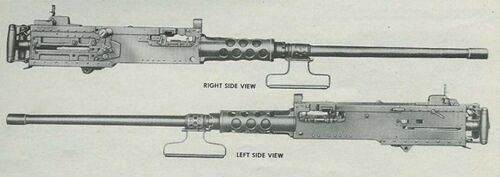
The heavy water cooled Mk 3 mounts were quickly replaced after the war started in favor of the lighter weight but still hard hitting heavy barrel air cooled model. Attachable E-11 or E-13 adapter plates allowed this gun to be quickly attached to a pintle mount. It could be brought into action in less than a minute, with a loader providing the belted ammunition. Even though a still hefty 84 lbs., this weapon was much easier to manhandle into a topside watertight locker or to a nearby hatch leading below. This gun was used with ravaging effect in the later stages of the war, when submarines found themselves interdicting small coastal craft.
Photo from War Department Technical Manual TM9-1225.
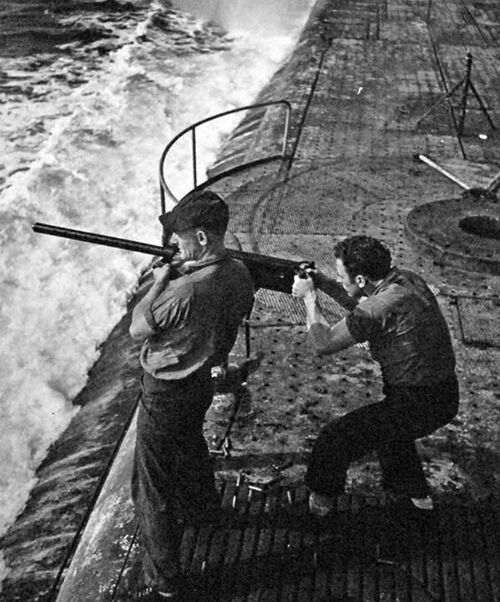
Crewmen from the Batfish (SS-310) engaging in some target practice in 1945. There could be up to four of these pintle mounts (two on each side of the fairwater), and perhaps one or two on the bridge or cigarette deck.
USN photo # 80-G-468650 via NARA and Navsource.org.
Automatic Cannons
20 mm Mk 5 and Mk 10
The first 20 mm mount to make it to the Submarine Force was the Mark 5, and it began to be fitted to submarines in early spring of 1942. The gun itself was made of corrosion resistant metals so that it could be left topside when the boat dived. At over 150 pounds the gun was too hefty to manhandle down a hatch. The mount was characterized by a tall, solid, narrow cone base with a single gun. Some boats received an extended version of the mount, ostensibly to increase the arc of fire. The extended mount was so tall that a raised semi-circular stand usually had to be installed around the mount so that shorter gunners could use the weapon. The increase in firepower thrilled the submarine crews, but ironically the weapon was rarely used in its intended role as an anti-aircraft weapon. The 20 mm was used mostly to shoot up small sampans and fishing boats. By late 1942 the gun had become standard equipment for new construction boats, with most fleet submarines carrying two of the weapons. It was used to great effectiveness throughout the war.
Later in 1943 the Mk 10 mount began to replace the Mk 5. This mount used essentially the same gun, but had a new open tripod style base that was considerably lighter in weight at only 850 lbs. Ship stability issues needed to be addressed as new guns were added and this was one way of cutting topside weight.
Both mounts were initially installed aboard submarines with two rectangular steel shields on either side of the gun. The intent was to provide the gunner with at least a modicum of protection during a gun action. Most submarine crews quickly dispensed with the shields as unnecessary, although pictures can be found both with and without the guards in place.
In late 1944 and into 1945 some of the Balao and Tench-class submarines began receiving the Mk 24 Mod 5 twin mount. It was usually sited on the main deck in whichever position that was not occupied by the deck gun. As far as can be determined, none of the pigboat era submarines carried this gun mount so it will not be featured here.
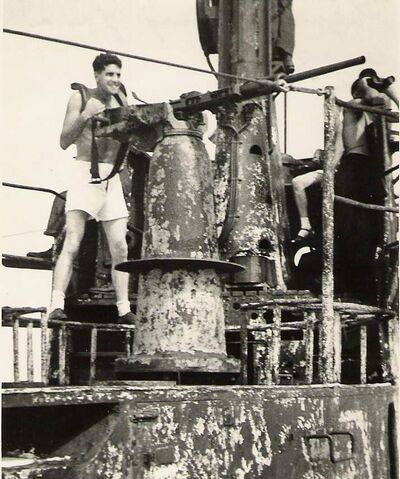
Pompano crewman Ralph Pleatman manning the boat's after 20 mm Mk 5 mount in 1943, located on the "cigarette deck" just aft of the bridge. Note the semi-circular platform he is standing on.
Photo courtesy of Rick Connole via Navsource.org.
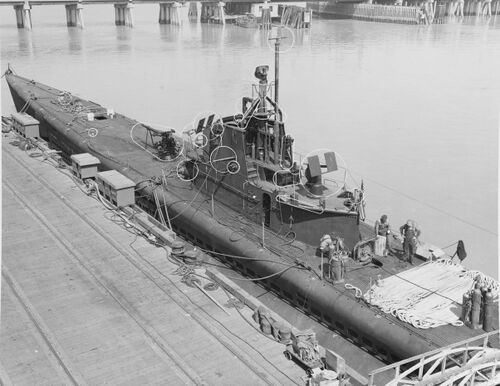
A 1943 photo of Salmon that shows her equipped with two of the Mk 5 mounts, both on the fairwater gun decks. The gun shields are installed on these brand new mounts, but the guns themselves have not as the boat was still in an overhaul at Mare Island. It was typical for the boats to dismount the 20 mm guns when stateside, as there was a minimal threat from enemy attack while inport in the U.S.
Photo 19-N-42439 courtesy of NARA and NHHC.
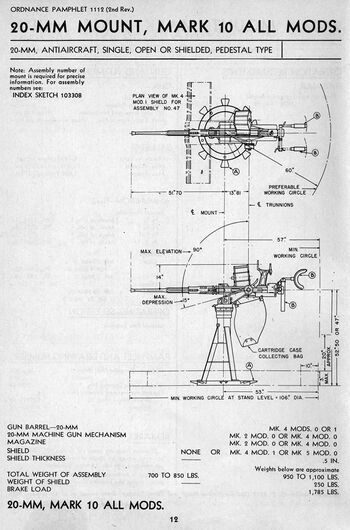
The Mk 10 mount was considerably lighter, 690 lbs less than the Mk 5. The gun was essentially the same. These mounts became ubiquitous on submarines by 1945.
Diagram from U.S. Navy BuOrd Pamphlet 1112
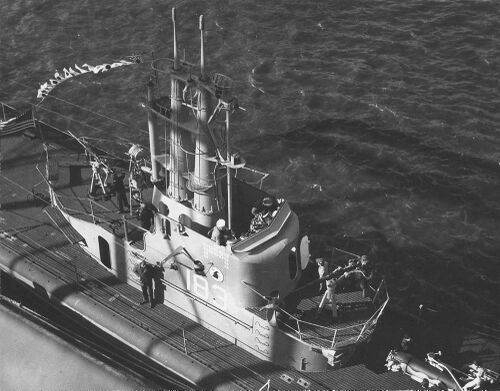
Seal (SS-183) is shown here post-war with two Mk 10 mounts on the fore and aft fairwater gun decks. There are no gun shields installed. A non-watertight door has been installed in the bridge fairwater to allow fast access for the gunner, who had to come up through the conning tower and bridge hatch. Typically, the spiral 60 round drum magazines were stowed in vertical watertight lockers in the deck at the gunner's feet. They could be quickly accessed and loaded onto the gun. When empty they were taken below and reloaded. At the next opportunity the topside lockers would be refilled with full magazines.
U.S. Navy photo.
40 mm Mk 3
On the occasions that submarines were forced to stay on the surface in the midst of an air attack (i.e. lifeguard pilot retrieval missions) the 40 mm provided a credible aircraft defense out to medium ranges.
When first evaluated by Navy BuOrd personnel in the summer of 1940, the weapon impressed the technicians with its potential. When the first units arrived in the U.S. from Bofors both BuOrd and Army personnel found the gun completely unsuitable for mass production. Way too much hand filing and machining was needed to get the parts to fit together and work properly. BuOrd personnel completely redesigned the gun and its mechanisms, greatly simplifying it and increasing its reliability. Production was greatly sped up and the Chrysler Corporation received a large contract to build them for both services. Other manufacturers were brought in and by 1944 large numbers of the weapons had made it to the fleet and to Army anti-aircraft units. The gun wasn't really a "Bofors" anymore as it bore little resemblance to its Swedish forebears.
The gun was too large to be fitted to S-boats and the Mackerel-class, and by the time it arrived in the force the remaining Porpoise-class submarines were rapidly aging and were being returned to the states for training duties. The Salmon/Sargo-class boats had stability issues that would have been exacerbated by these heavy gun mounts and thus none of those submarines received the 40 mm mounts. The guns were installed on several of the surviving Tambor/Gar-class boats, and of course they saw extensive service on the Gato/Balao/Tench-class submarines.
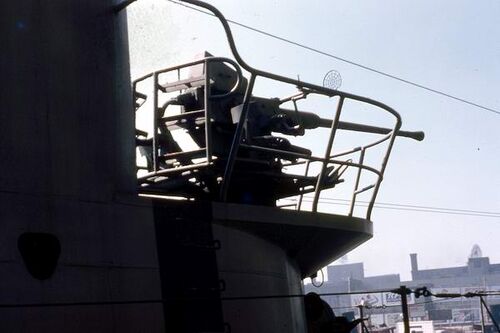
A 40 mm Mk 3 mount on the Tautog (SS-199) after the war. Where the mount was placed was up to the crew, and many skippers chose to have it mounted on the forward fairwater gun deck, giving them maximum tactical flexibility as they approached the target.
Photo by Gilbert M. Bohannon, Jr., in the private collection of Ric Hedman.
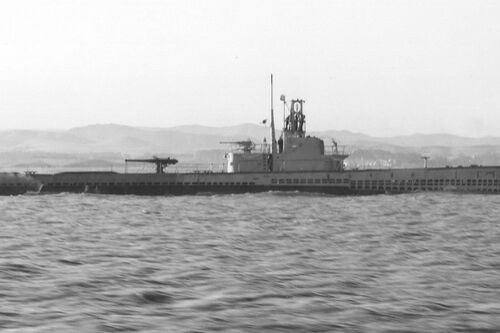
This closeup of Tambor (SS-198) in February 1945 shows her with a Mk 3 mount on the aft fairwater gun deck, aka the "cigarette" deck. The mount sits on a deck directly over the main air induction valve and the main ventilation valve. The mast directly ahead of the mount is the SD air search radar mast.
Photo #1381-45 from NARA, via Navsource.org.
Deck Guns
3"/23 Mk 9
The gun proved to be less than thrilling in its performance. It fired a small (13 lb.) shell that had only a .28 lb bursting charge. With the short 69 inch barrel the muzzle velocity was low. Combining these two factors resulted in a gun that lacked the hitting power to finish off even small targets quickly. It did not have any sort of central fire control and was used in line-of-sight mode only, thus limiting its accuracy from the pitching and rolling deck of a small submarine. The tub used up a lot of space inside the small submarines, making it difficult for the crew to move about.
Reports were also received that the gun had the unnerving tendency to spontaneously retract into its tub without warning, especially with the recoil of firing. This obviously presented a dangerous safety hazard to the gun crew.
The gun was installed on most of the L-class boats, the M-1, the O-class, the San Francisco built units of the R-class (soon replaced with a 3"/50), and on the S-1. A revised design for the lower mount was installed on the O and R-class boats that was lighter weight, taller, and provided some ready service ammunition stowage clips. As far as can be determined, the Navy did not give this revised mount design a different mark or mod number. It was still referred to as the Mark 9. The shortcomings of the gun and the mounts had it removed from the L and O-classes after the end of WWI, and the installations on the R-boats and S-1 were short lived. By the mid 1930s it was gone altogether.

This photo shows the gun raised and trained to starboard on the M-1. Note the very small amount of deck space to work the gun.
Photo in the private collection of Ric Hedman.
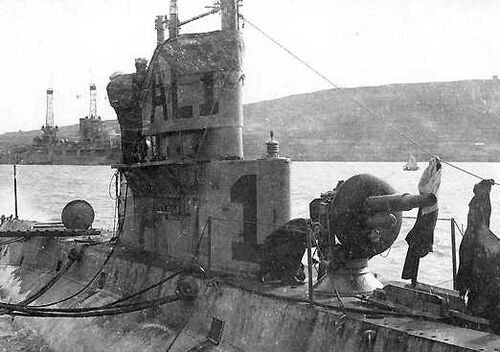
A view of the raised gun on L-1 from forward. The circular shield is clearly seen, with the recoil cylinder protruding below the barrel. This was the original version of the mount, with the cone shaped base. It was used on the L-class and the M-1.
Photo via Navsource.org.
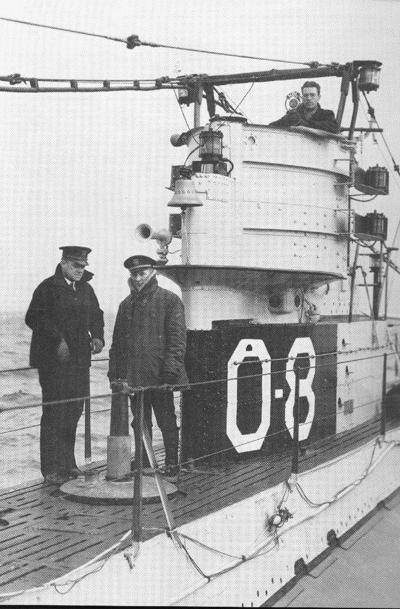
The gun shown retracted on the O-8, just in front of the two officers, early 1920s. In this mode the gun looked like a thick stanchion post. The gun tub penetrated the pressure hull in the forward battery compartment and used up a lot of space. This was another reason that the gun was disliked by the crews.
Photo in the private collection of Ric Hedman.

This photo shows the raised mount on the R-20, 1919. This is the revised mount that was used on the O and R-class submarines. It had clips on the side between the base and the gun that held ready service ammo, used until more rounds could be handed up from below.
Photo courtesy of the Vallejo Naval & Historical Museum in Vallejo, California via Darryl Baker.
3"/50 Mark 7 Mod 19
The gun became available during the construction of the R-class in 1918. Its characteristics so impressed the force that it was ordered to replace the 3"/23 Mark 9 that had been originally specified for those boats. Delays in production of the gun caused the west coast built units of the R-class (R-15 to R-20) to get the original 3"/23. The east coast units were built with an expanded deck sponson needed to operate the new 3"/50, but the guns themselves were not installed until after the boats were commissioned. R-15 to R-20 had the Mark 7 retrofitted during overhauls in 1919.
Seeking to discourage aggressive skippers from making surface gun attacks, the Navy's General Board dictated that the new fleet submarines of the Porpoise-class of 1934-1935 be equipped with this gun. Later overhauls had these boats upgunned with the more modern 3"/50 mounts, with some boats receiving the 4"/50 Mark 12.

The Mark 7 gun on the R-7. These boats could train the gun either forward or aft for transits. In this picture the forward bipod barrel lock is engaged. On the far left the square plate that the breech cover attached to is just visible.
Photo in the private collection of Ric Hedman.

R-17's Mk 7 gun shown trained aft. This gives a good view of the box-shaped breech cover. It would be removed and set aside as the gun crew swung the gun into action. It took just seconds to put it back in place.
National Archives photo.
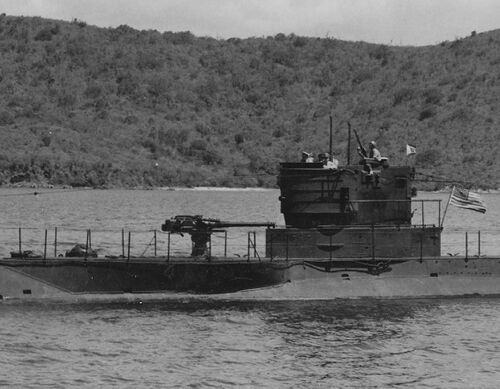
R-12's gun trained aft and secured to a barrel lock on the forward edge of the conning tower fairwater, circa 1942. It also appears as if the box-shaped breech cover is not installed in this photo. Note the M1917 Lewis gun mounted on top of the bridge aft of the periscopes.
National Archives photo 80-G-7252 via Sean Hert and Navsource.org.
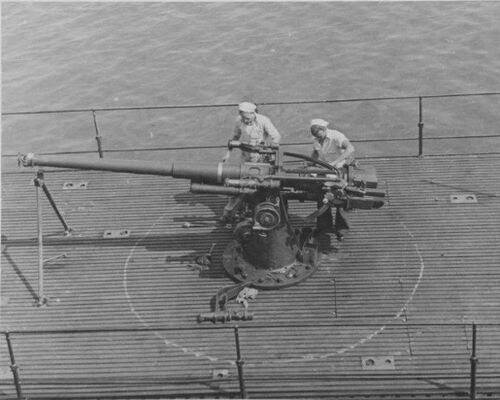
Two crewmen performing maintenance on Permit's Mark 7 gun, circa 1939. This is a good overhead view of the gun, and the installed breech cover is clearly seen on the right. One of the pointing scopes has been removed and is laying on the deck. The bipod barrel lock on the left folded down to the deck when not in use.
Photo courtesy of Tommy Trampp via Navsource.org.
3"/50 Mark 18 Mod 0
Most of the boats that received this mount as original equipment would have the gun replaced by later 3" or 4" mounts.

The Mk 18 Mod 0 mount on Plunger (SS-179) at Midway Island, July, 1942. Crewmen are performing maintenance, a never ending task for a deck gun. Even with corrosion resistant materials a submarine deck gun is not corrosion proof, and therefore detailed and regular maintenance is require to keep the gun operational. Plunger would not retain this gun for long. It would be swapped out for a high elevation model during her next overhaul.
U.S. Navy photo.
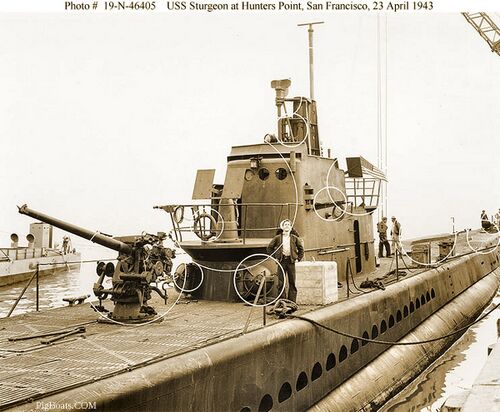
A great photo of Sturgeon (SS-187) at Hunter's Point undergoing overhaul in 1943. The Mk 18 Mod 0 gun is mounted forward of the fairwater, reflecting the crew's preferences. Overall, having the gun forward allowed the tactical advantage of being able to approach the enemy while firing. Two watertight lockers have been installed under the forward fairwater gun deck, at the base of the fairwater. These lockers stored ready service ammo for the gun, allowing it to come into action quicker while an ammo passing train was being set up from the magazine below the galley.
Note the 20 mm Mk 5 mounts with the gun shields on the fore and aft fairwater gun decks.
Photo 19-N-46405 courtesy of the NHHC.
3"/50 Mark 11, 19, 21 Various Mods
Why exactly these high angle mounts began to equip submarines is not entirely clear. Submarine doctrine had always de-emphasized fighting an aircraft while on the surface, sometimes to the point of actually banning it. The Mk 7 and 18 single purpose (SP) mounts used essentially the same gun, so why would the Submarine Service equip submarines with a dual purpose (DP) mount? The most likely reason is simple availability. More of the DP mounts were being built for the surface fleet, so it may have made logistical sense to adapt them to wet mounts and use them on submarines.
The three Marks listed here were wet versions built specifically for submarine use, using corrosion resistant materials (stainless steel, copper-nickel, brass) and watertight breech mechanisms. All of these Marks were very similar in appearance, making it very difficult to visually tell them apart from a distance. Differences likely included shorter overall length (it only varied by a few inches), different building materials, different overall weights, and changes in minimum and maximum elevation. For instance, the Mark 11 mounts had a -10 to +88 elevation capability, the Mark 19 -15 to +88, and the Mark 21 -13 to +85.
These mounts first appeared on the V-1/Barracuda-class submarines starting in approximately 1928-1930 as replacements for the original 5"/51 caliber guns. These boats had stability problems and this was done to reduce topside weight. The two Cachalot-class boats received them as original equipment in 1933-34. The guns did not appear again until 1940-1941 when they were installed during construction on the Tambor/Gar and Gato-class boats. Modernization efforts for the older S-class in 1943 saw the original 4"/50 caliber guns on these boats replaced by 3"/50 caliber guns of these Marks.
Despite the fact that these gun mounts were fully capable of anti-aircraft fire, it is highly unlikely that any submarine actually engaged an enemy aircraft with one. The reasons are two-fold: first, the mounts are all manually operated in both elevation and train, making the accurate tracking of a fast moving aircraft somewhat problematic. Second, given the doctrinal rejection of the idea of staying on the surface and shooting at an attacking aircraft, it is highly unlikely that the properly fused ammunition for this use was ever issued to a submarine.
These guns were employed mostly in shooting up ships already crippled, or in attacking small craft not worthy of a torpedo. In this role they were somewhat lacking in hitting power, with early war experience backing this up. Submarine crews soon were calling for a more substantial gun, and many boats that carried this gun had it replaced with the more powerful 4"/50 or (later) the 5"/25 caliber weapons. Six of the Tambor/Gar boats had theirs replaced with a 5"/51 that had originally equipped the Barracuda-class boats in the 1920s.
Excerpts from U.S. Navy Ordnance Pamphlet 1112 showing the six different wet mount versions for this gun. Click to enlarge each image. As you can see the mounts are all very similar in appearance, making it difficult visually to identify which Mark/Mod was on a submarine at an given time. There were small differences in gun dimensions and mount weight, and in the amount of depression/elevation. A common trait is a stand near the base of the mount for use by the gun captain. These mounts were tall due to their original use as anti-aircraft mounts, and this height meant that it was difficult to properly sight the gun from the main deck.

A closeup of Grampus on her sea trials in the spring of 1941, showing her gun installation on the aft deck. The bipod barrel lock would fold down to the deck when the gun was in use. The boat's magazine was below the crew's mess and galley, so a ammo passing train would be set up from the magazine and up the after battery hatch sited between the gun and the fairwater. The location of the magazine and the relatively short passing train was a primary reason that the as-built location for the gun was aft.
Photo 19LCM courtesy of NARA and Navsource.org.

Silversides (SS-236) taking on a Japanese picket boat on October 14, 1942. The man on the left is receiving ammunition passed up to him through the after battery hatch from the magazine below the crew's mess. This passing train limited the effective rate of fire to probably 8-10 rounds per minute. This prompted the later addition of topside watertight ammunition lockers that could be quickly accessed in order to get the gun into action faster with a higher sustained rate of fire.
Given the shape of the mount base, this gun is likely a Mark 11 Mod 8 or 9.
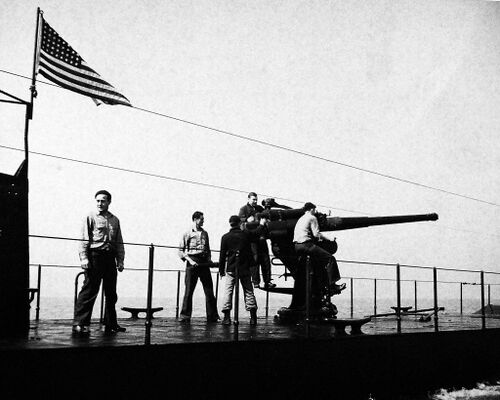
The gun crew of Cuttlefish (SS-171) undergoing a drill in June, 1943. This gun is likely a Mk 11 Mod 8. A gun action required numerous men to be on deck, including ammunition passers, loaders, the gun captain, and two men to handle elevation and train. Note the gun captain standing on the elevated platform.
Photo 80-G-41788 courtesy of NARA and Navsource.org.
4"/50 Mark 12 Various Mods
In the 1920s the service flirted with big guns on the early V-class boats, but when they reigned in the trend of gigantism with 1932's Dolphin the medium sized submarine dictated a return to the 4"/50. In Dolphin's case a new Mod 21 version of the venerable Mk 12 gun was introduced that had a watertight side swinging breech that did not use the removable cover.
When the Navy's General Board for Design began drawing up the specifications for the new fleet submarines of the Porpoise-class in 1933/1934 they were stricken with a sudden case of conservatism and this class and all follow-on classes of fleet submarines, up to the Gato-class of 1941 were specified to carry 3"/50 caliber guns. Unwarranted fears of "reckless" submarine skippers engaging in unwise gun duels lead them to limit the gun size, and thus the temptation, to use it. The board compromised only in allowing a gun foundation strong enough to handle a larger gun, should it become necessary later. Immediately upon the commencement of hostilities the submarine crews put forth a torrent of requests for a harder hitting gun so the Navy pulled out a large number of the Mk 12 guns that had been in storage and began to refit the Gato-class boats in an expeditious manner. The crews liked the new gun and it became the preferred weapon. Contracts were signed for new-build versions. It was even specified as original equipment for the new Balao-class submarines then under design.
As far as can be determined, the Submarine Service employed eight different versions of the Mk 12 (see below), three with breech covers, and five with watertight breech blocks. Strangely, even though it was a significant alteration, the Bureau of Ordnance did not assign a different Mark number to the units with the watertight breech blocks, only a different Mod number. Different manufacturers likely accounted for the large number of Mods.
The favored version seems to have been the Mods 6, 11, and 43 with the removable covers. Photographic evidence shows that these versions made up the majority of the guns. Some of the guns retrofitted to the early Gato-class boats likely came from decommissioned S-boats.
As the war progressed, even the well-liked 4"/50 was found to lack the power necessary to finish off cripples or small craft quickly enough. In 1944 the 5"/25 caliber gun was introduced and it became the favored gun throughout the service, retrofitted to older boats and as original equipment on the new Tench-class submarines.

This is the original wet version of the Mk 12 gun, the Mod 6. The Mods 11 and 43 were very similar. The Mod 43 was likely a new production version as opposed to the older mods coming from existing stock. Most of the 4"/50 caliber guns that equipped USN submarines were of these three Mods.

The Mod 21 version that was aboard the Dolphin (SS-169). The Mods 38, 40, 41, and 44 were very similar. These mods did away with the removable cover over the breech, replacing it with a watertight version of the Smith-Asbury side swinging breech. How many of these mods made it out to the fleet is not known for sure. Photographic evidence seems to suggest that it was not many.
Two views of the Mk 12 Mod 6 on S-boats. On the left the crew of S-26 is performing the never ending chore of maintenance. A long sectional ram rod is being employed to push and pull pillows through the bore of the gun, cleaning out lead and powder residue. On the right S-37's crew is preparing for a gunnery exercise. They have removed the breech cover and the loader is about to open the breech. The cover is held down onto a rubber gasket by two clamp arms. The process of removing the cover prior to action and then reinstalling it prior to diving used up valuable time.
Photos in the private collection of Ric Hedman.
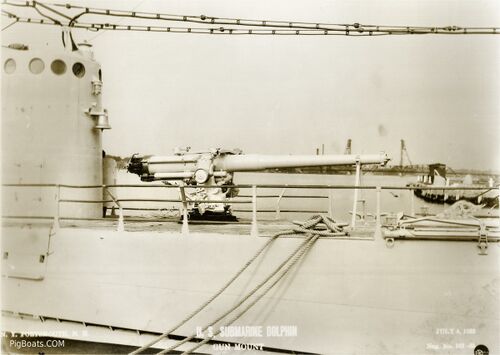
An excellent photo of Dolphin (SS-169) in 1933 showing her Mk 12 Mod 21 weapon. This was the first version to have the watertight breech, eliminating the removable cover. This version was very similar to those mounted on the Caldwell, Wickes, & Clemson-class destroyers, only with a wet kit conversion.
U.S. Navy photo contributed by Roger Torgerson.
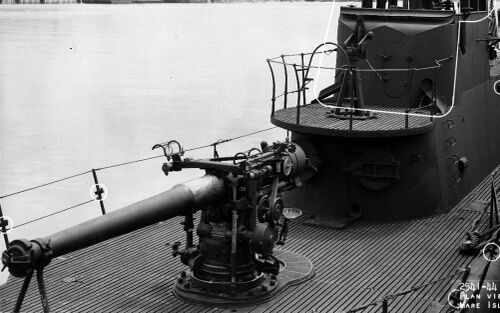
The gun installation on USS Flier (SS-250) during an overhaul period at Mare Island in April, 1943. This gun is likely a Mod 38 version. The triangular frame atop the weapon supported the telescopic sights for both operators. More often than not, the Gato-class boats installed this gun on the forward deck, although it could also go aft. There are two ammunition storage lockers installed on the lower forward end of the fairwater. These provided ready service ammo to get the gun into action quickly. Extra ammo was passed up through the conning tower hatch and slide down to the passers via the two chutes seen at the lower edges of the bridge fairwater. Note the 20 mm Mk 10 mount on the forward fairwater gun deck.
U.S. Navy photo NH 98328 via NHHC.
5"/51 Mark 18 Mod 0
Since it was to be used on the low pitching deck of a submarine, the gun was also modified with a screw box liner, breech, and chamber to allow the use of semi-fixed ammunition. In semi-fixed ammunition the "bullet" can easily be separated from the brass propellant case to make for easier handling. A full up round consisting of the projectile, propellant charges, and casing weighed approximately 104 lbs., making it difficult for a single man to carry. Detaching the projectile from the propellant charge made it much easier for the passers to get the round to the weapon, and the brass case protected the propellant charge from getting wet while on deck.
With the gun measuring a hefty 22 feet long and weighing in at over 10 tons it was a sizeable and somewhat awkward gun to operate on the still small gun deck of the V-1 class boats. The V-1 and her two sisters had stability problems so after only 3.5 years of service the Mk 18 guns were removed from the boats in favor of the much smaller 3"/50 caliber Mk 11 gun. This helped the stability issues, but did not completely solve them. The Mk 18 guns were placed in storage along with the spares. This proved to be a fortuitous decision.
In the spring of 1942 Rear Admiral Charles Lockwood, the Commander, Submarines Southwest Pacific made a personal appeal to the Bureau of Ordnance asking them to release the stored Mk 18 guns so that they could be installed on submarines under his command. Lockwood had been a pre-war advocate of using larger guns on submarines, but the General Board did not agree with his views and would only agree to have a foundation strong enough to have a 5 inch gun installed on the Tambor/Gar-class boats. In the dynamic war situation of the spring of 1942 the Bureau no longer had any objections so they immediately released the guns. They were installed on six of the Tambor/Gars (Tambor, Thresher, Tuna, Gar, Grayback, and Gudgeon) during their next stateside overhauls, aft of the fairwater. The much larger size of the gun dictated that the deck sponson around the gun be expanded outward to port and starboard, in order to give the gun crew enough room to work. Curiously, photographs of Grayback indicate that the deck was not expanded as it was on the other five boats. The reasoning behind this is not known.
Although these guns provided a much-appreciated boost in hitting power, in use they proved to be somewhat problematic. They were large and heavy, with a relatively slow rate of train and elevation. Gun crews had to watch their footing while using the gun, as the available room on the aft deck was minimal, even with the expanded sponson on some of the boats. The rate of fire was lower than desired, and the heavy (104 lb.) round was difficult to handle, even when the projectile was separated from the casing.
Only the six Mk 18 guns were deployed to the force, and no further guns of this type were acquired. The later 5"/25 caliber Mk 40 mount (see below) was a much better choice and saw widespread use before the end of the war.

Secretary of the Navy Curtis Wilbur (civilian, center left) inspecting the Mk 18 gun on V-1 (SF-4) at the Portsmouth Navy Yard, December 3, 1924. The very long barrel of the gun is quite evident, along with the large deck necessary to operate the weapon.
Note the twin cylinders below the barrel that helped control the substantial recoil of the weapon when fired.
Library of Congress print #npcc 12734 via Navsource.org.
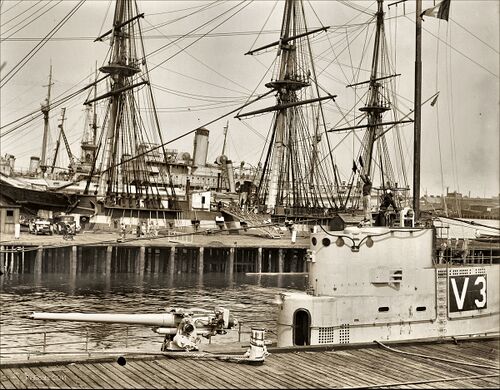
V-3 moored at the Boston Navy Yard in Charlestown, MA. with the USS Constitution, "Old Ironsides" in the background. The date is not known for sure, but is believed to be between May, 1926 and November, 1927. This photo gives a good side view of the Mk 18 weapon on V-3's forward deck. The large oval shaped opening in the side of the fairwater lead to a gun access trunk that lead down into the control room. The gun crew would use this trunk to rapidly access the gun deck during a surface action. The trunk could also be used to access the bridge directly from the control room.
Boston Public Library/National Archives photo.

Gudgeon underway in San Pablo Bay off Vallejo, CA. following an overhaul there in 1943. The Mk 18 gun is clearly seen on her after deck, along with the expanded sponson necessary to operate the gun. This photo also shows the boat with two 20 mm Mk 10 guns on both of her fairwater gun decks.
Photo 5767-43 from NARA San Francisco via Tracy White and Navsource.org
Page created by:
Ric Hedman & David Johnston
1999 - 2023 - PigBoats.COM©
Mountlake Terrace, WA, Norfolk, VA
webmaster@pigboats.com

